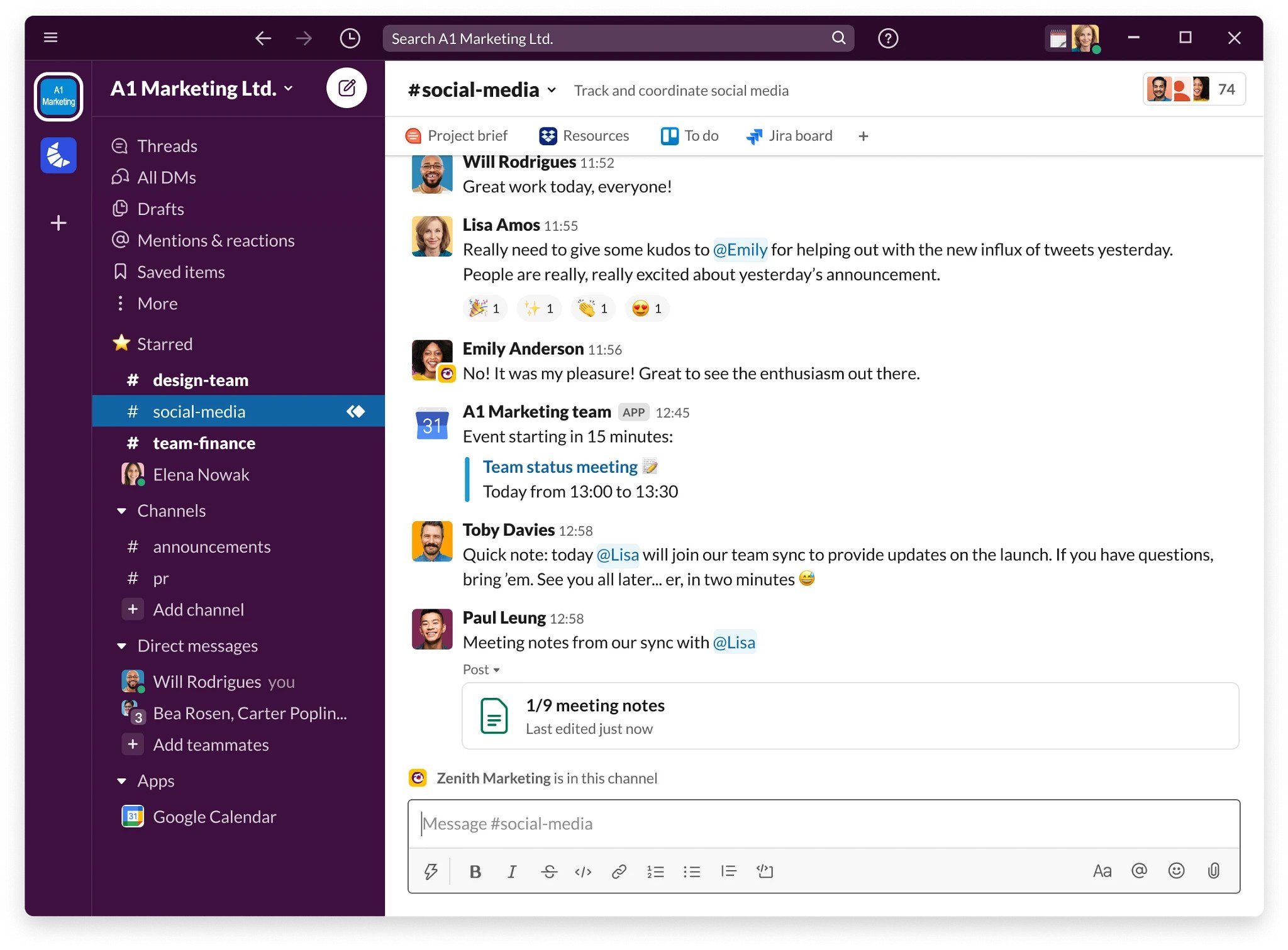I've worked 100% remotely since 2015, with a few years of partial remote work before that. I've been covering remote work trends since around the same time and even wrote a book called The Everything Guide to Remote Work that goes into incredible detail about all the various aspects of remote work and hybrid work. And every so often, I need a refresher on how to stay happy and productive while doing it.
Each of us faces unique challenges when working remotely, not only because of our different personalities but also due to our various lifestyles and the type of work we do. Still, many of the core issues we face as remote workers are similar.
Here are 20 tips for leading a better and more productive remote-work life, based on my experience and what I've learned in my years of covering remote work as a writer.
1. Maintain Regular Hours...Most of the Time
Set a schedule and stick to it...most of the time. Having clear guidelines for when to work and when to call it a day helps many remote workers maintain a healthy work–personal life balance.
That said, one of the best benefits of remote work is flexibility when the job allows for it. Sometimes, you need to extend your day or start early to accommodate someone else's time zone. When you do, be sure to wrap up earlier than usual or sleep in a bit the next morning to make up for it.
Automatic time-tracking apps, such as RescueTime, let you check whether you're sticking to your schedule. They can also help you figure out what times of day you're most productive versus when you slack off. You can use that information to your advantage by protecting the hours when you're most likely to get difficult work done. For example, if you tend to have high productivity between 9:30 and 11:30 a.m., don't schedule meetings during that time.
 (Credit: RescueTime)
(Credit: RescueTime)2. Create a Morning Routine
Deciding you'll sit down at your desk and start work at a certain time is one thing. Creating a routine that guides you into the chair is another.
A routine can be more powerful than a clock in helping you get started each day. What in your morning routine indicates you're about to start work? It might be making a cup of coffee before you tackle your to-do list. It might be returning home after a jog or getting dressed. (Wearing pajamas is a work-from-home perk for some but a bad strategy for others.) Look for an existing habit that you have, like brushing your teeth or coming in from a dog walk, to act as your signal. That way, you can tack on the new habit of kicking off your workday.
I say "morning routine," but not everyone who works from home follows a nine-to-five schedule. Yours might be a "getting started" routine at another time of day. Nevertheless, look for an existing habit you have and try to start your work day after it.
3. Set Ground Rules With the People in Your Space
Set ground rules with other people in your home or who share your space when you work.
For example, if you have children who learn at home or who come home from school while you're still working, they need clear rules about what they can and cannot do during that time.
If you share a space with another adult who's home at the same time, you may have to negotiate quiet times, meeting times, and any shared equipment, like desks and chairs. Simply knowing that another person has a meeting at a certain time helps you prepare to work around it. You might need to get a pair of socks from the bedroom before another person goes in there and closes the door for a meeting.
Additionally, just because you're home and can let in service people or take care of pets doesn't mean other family members should assume you always will. As I put it in my book, "You're a remote worker, not the house manager." If you choose to take on the bulk of the domestic labor because you work from home, that's fine, but if you simply take it on by default because you're home, you may feel taken advantage of, and your ability to get your job done may suffer.
4. Schedule Your Breaks
If you work for an organization, know the policy on break times and take them. If you're self-employed, give yourself adequate time during the day to walk away from the computer screen and phone. A lunch hour and two 15-minute breaks seem to be the standard for full-time US employees. For computer-based work and other sedentary work, it's important to stand up and move to get your blood circulating every so often, at least once an hour. It also helps to move your eyes off of the screen regularly, even if it's a micro-break of 10 to 20 seconds.
5. Take Breaks in Their Entirety
Don't short-change yourself during breaks, especially your lunch hour or meal break. There are apps, such as TimeOut for Mac and Smart Break for Windows, that let you set a schedule for when you'll lock yourself out of your computer. I personally find those apps to be more trouble than they're worth. Establishing a routine is a much better and more reasonable solution in my mind.
Set an alarm or timer on your phone, or simply mind the time with a standard clock. No matter how you track your breaks, make sure to take them in their entirety. For example, if you plan for an hour break and return to your desk after only 40 minutes, walk away for another 20.
6. Leave Home
To the extent that you can, get out of the house and move your body. Your body needs blood circulation. Plus, the fresh air and natural light will do you good. Ideally, step outside for at least a short while before, during, and after your working hours.
This same advice applies equally to people who do in-person work. Leave the building at least once a day during working hours.
If your circumstances and conditions allow, you might also go to cafes, libraries, and co-working spaces to break up the monotony of being at home. That's great, but the really important part is to leave your home, get some air and natural light, and move.
You don't have to go to crowded public spaces to get away from your solo workspace. Take a walk. Weed the garden. Sit on the stoop. You get the picture.
7. Don't Hesitate to Ask for What You Need
If you're employed by a company or organization that supports your work-from-home setup, request the equipment you need as soon as you start working from home or within a few days of realizing you need something new.
It's extremely important to set a precedent early that you will ask for what you need to get your job done comfortably. These items might include the right monitor, keyboard, mouse, chair, desk, printer, software, and so forth. Organizations that are accustomed to remote employees often have a budget for home office equipment. Ask what it is and how often it's renewed. It also doesn't hurt to ask whether there's a loan agreement or who will pay for return shipping or disposal of outdated equipment. Some remote organizations allow employees to bring in a consultant to make sure their workspaces are set up to be ergonomic.
If you're working from home temporarily and are expected to return to an office when it's safe, ask for what you need but be willing to make acceptable compromises. Ordering a new office chair and desk might be off the table. Instead, a mouse, keyboard, laptop riser, and back-supporting cushion go a long way, and they can cost less than $200. There are other cheap and easy ways to improve your home office, too.
 (Credit: Sonic Electronix)
(Credit: Sonic Electronix)8. Keep a Dedicated Office Space—Even If It's Just a Chair
In an ideal world, remote employees would have not only a dedicated office but also two computers, one for work and one for personal use. This arrangement would be more secure for the employer and would allow you to do all of your NSFW activities in private.
But not everyone has a spare room to use as an office in their home, and keeping two machines isn't always realistic. Instead, dedicate a desk or table space—or even a particular seat at the kitchen table—that you'll use only for work.
You may want to create a separate user account on your computer to separate your work activities from your personal stuff. Making even small points of differentiation between work time and personal time helps your brain know when you're off the clock, which contributes to clearer boundaries.
9. Maintain a Separate Phone Number
If your job involves taking old-fashioned phone calls, set up a phone number that you only use for calls with colleagues and clients. It doesn't have to be a landline, a second mobile phone, or even require a SIM card. It can be a VoIP service, such as Google Voice or Skype.
Similar to some of the other tips, having a separate phone number helps you manage your work-life balance and boundaries.
10. Use a VPN
Use a VPN whenever you're connected to a network that you don't control. That includes Wi-Fi at co-working spaces, cafes, libraries, airports, hotels, and so forth. Organizations often have their own VPNs that off-site employees need to access certain servers or websites that store information meant only for internal use. In those cases, you'll also need to use a VPN at home. It's a good idea to get into the habit of leaving your VPN connected as often as possible because it's always safer to have it on than not.
VPNs are one security measure, and there are other steps you can take to increase security while working from home. One more point about VPNs: When you're connected to an organization's network, your employer could conceivably see what you're doing, so don't view porn via a corporate VPN.
11. Socialize With Colleagues
Loneliness, disconnect, and isolation are common problems in remote work, especially for extroverts. Building relationships with colleagues remotely takes effort. Companies with a remote work culture usually offer ways to socialize. For example, they might have channels in a team messaging app, like Slack, for talking about common interests or organizing meetups for people in the same region.
How much interpersonal interaction do you need to feel connected and included at work? The answer is not the same for everyone. Even if you're highly introverted or don't like socializing at your job, give a few interactive experiences a try, whether it's an online happy hour or a book club, so that you're familiar with them if you ever decide you want them. If your workplace doesn't have a strong remote culture, you may need to be more proactive about nurturing relationships.
As much as team messaging apps are excellent venues for socializing, they tend to create distractions, too; check out these tips on how not to get overwhelmed by Slack.
 (Credit: Slack)
(Credit: Slack)12. 'Show Up' to Meetings and Be Heard
Certainly, you'll participate in video conferences and conference calls while working remotely. It's a good idea to attend optional meetings from time to time as a way to be seen. Be sure to speak up during meetings so everyone knows you're on the call. A simple "Thanks, everyone. Bye!" at the close goes a long way toward making your presence known.
If your company uses Zoom Meetings for video conferencing, our story on Top Zoom Tips for Better Video Calls will help you quickly master its ins and outs.
13. Get Face Time
If your employer is lax about getting you in a room with other employees, ask to have an annual or semi-annual trip in your contract. It could be for planning, training, or team building. Or, tack it onto some other business event, such as a yearly fiscal meeting, nearby conference, or office holiday party. Don't wait around for someone to invite you to the office or an event. Be proactive. Make the ask.
For those unexpectedly working from home who are also trying to reduce face-to-face contact, set up a video call with your colleagues or manager once a week to check in. Don't be afraid to let check-in meetings be as short as they need to be. Sometimes, a five-minute conversation is all it takes to stay connected.
14. Take Sick Days
When you're not well, take time off. If sick days are part of your compensation package, take the time off that you need. Not taking it is like throwing away money!
If you're self-employed and don't get paid sick time, it can be tempting to power through illnesses and keep working. Remember that for your long-term wellness and productivity, it's best to rest and get better so that you can get back to work at full capacity.
15. Look for Training and Learning Opportunities
When you're not in an office with your fellow employees, you might miss out on training and skills development courses that are taught in person. Your company might even forget to add you to its online training courses. It can be tempting to regard this as a dodged bullet, but you might be missing out on an opportunity to learn something useful. Speak up and make sure you're included.
 (Credit: LinkedIn/PCMag)
(Credit: LinkedIn/PCMag)In addition to top-down training, you can request online or in-person courses, training, and coaching if you need it. There are also plenty of online learning sites that teach business soft skills, programming, software skills, and other courses. Remote companies often have a budget for learning and skills training. If your organization doesn't, ask if they might add it.
You might also be eligible for learning opportunities at your organization's headquarters or other workspace. That way, you get training and face time with colleagues in one go.
16. Over-Communicate
Working remotely requires that everyone over-communicate.
Tell everyone who needs to know about your schedule and availability often. Don't assume they'll remember. When you finish a project or important task, say so. Over-communicating doesn't necessarily mean you have to write a five-paragraph essay to explain your every move, but it does mean repeating yourself. Joke about how you must have mentioned your upcoming vacation six times already, then mention it again.
17. Be Positive
Reading tone in written messages is really difficult in all-remote settings. The less face time you have with people, the more an intentionally concise message can come off as terse and short-tempered.
In remote work settings, everyone must be positive, to the point where it may feel like you're being overly positive, gushy even. Otherwise, you risk sounding like a jerk. It's unfortunate but true. So embrace the exclamation point! Find your favorite emoji. You're going to need them :D
18. Take Advantage of Your Perks
For years, I've baked a loaf of bread nearly every week, and usually during the workweek. Why? Because I'm home and I can. I love baking bread, but you need to be there to tend to it once an hour or so to punch down the dough, shape the loaf, and let it bake. It doesn't take a lot of hands-on time, but you need to be around. When I worked in an office full-time, I struggled to find half a day when I was home to bake.
Working remotely comes with unique perks. Take advantage of them. You deserve it.
19. Don't Be Too Hard on Yourself or Others
Successful remote employees have a reputation for being extremely disciplined. After all, it takes serious focus to do any full-time job from an unconventional space.
That said, everyone lets their attention drift sometimes. If you find yourself working one minute and researching vacation house rentals the next, don't reprimand yourself too harshly. Instead, ask yourself whether people in an office setting do the same thing. If the answer is yes, cut yourself some slack, then get back to work. Above all, remember that you need to balance productivity with self-care. Otherwise, you risk burning out.
During the COVID-19 pandemic—but really all the time—we need to extend this same kindness and forgiving attitude to our co-workers, clients, and bosses. There is an extraordinary amount of stress and anxiety during a global pandemic. Keep in mind that you may not know what another person is going through not only in life but also in their home work environment. Cut them some slack.
20. End Your Day With a Routine
Just as you should start your day with a routine, create a habit that signals the close of the workday. It might be a sign-off on a business messaging app, an evening dog walk, or an at-home yoga class. Something as simple as shutting down your computer and turning on a favorite podcast will do. Whatever you choose, do it consistently to mark the end of working hours.
Make It Personal
Above all other advice and tips, figure out what works best for you. Sometimes, the answer is apparent; other times, you might need inspiration from other remote workers in the same boat. A supportive community is out there, whether you find it in your organization's Slack channel or online through blogs or Reddit. Consider, too, that you might need to shake up your routine once in a while, lest it get too...routine.

